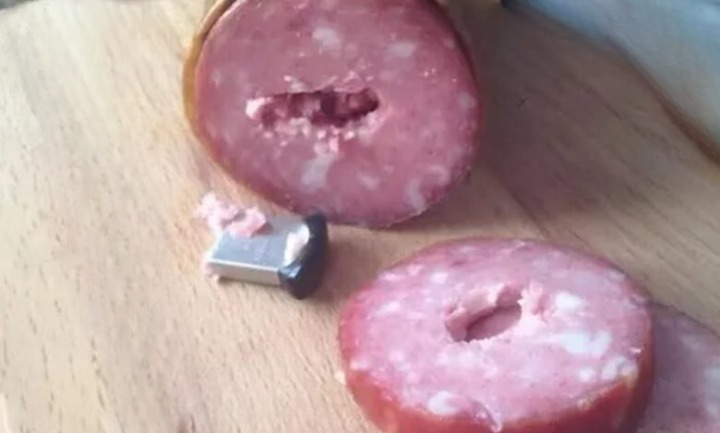The entire ordeal began in the most ordinary way. I had gone to the grocery store, picked up a mid-priced sausage—nothing fancy, nothing unusual—and used it to make a couple of simple sandwiches. I sliced off a few pieces, ate them without a second thought, wrapped up what was left, and stuck it in the refrigerator. A completely normal, forgettable part of my day.
But the next morning, normalcy ended.
As I prepared breakfast, I pulled the sausage out again and set it on the cutting board. The moment I pressed the knife into it, something felt wrong. The blade hesitated mid-cut, catching against an unexpected hardness buried inside the meat. I frowned, assuming it had partially frozen or that the manufacturer’s casing was unusually tough.
I tried again—this time forcing the knife downward. It stopped completely, stuck as if lodged in stone. Irritated, I leaned closer to inspect the blockage. That’s when I saw it: a glint of something smooth, metallic, and entirely out of place.
A cold ripple of unease spread through me. Maybe a piece of factory machinery had broken off? Some accidental metal contamination? But the fact that I had already eaten slices from this very sausage made my stomach twist with nausea.
Slowly, carefully, I dug into the meat to extract the foreign object.
What emerged was not machinery.
It wasn’t metal debris.
It was a USB flash drive.
A perfectly ordinary thumb drive—sealed inside a mass-produced food product.
Revulsion washed over me, followed swiftly by a deep, burning curiosity. How could a consumer electronic device end up inside a sausage? This wasn’t a cheap brand, either. The chances of this being an accident were astronomically low.
Despite the bile rising in my throat, I couldn’t just throw it out. I needed to know what was on it.
Hands trembling, I plugged the USB into my computer.
The drive mounted instantly. Its contents were minimal, but strangely deliberate. There was only one folder, written in stark capital letters:
OPEN ME
My pulse thudded in my ears. I double-clicked it.
Inside was no manifesto, no cryptic document, no suspicious data dump.
Just one photograph.
I opened the image. The moment it filled my screen, I jerked backward.
A man stared out at me—mid-to-late thirties, clean-cut, smiling in a way that felt deeply wrong. His smile wasn’t warm; it was smug, knowing, almost mocking. He was looking straight into the camera, as if looking directly at me.
It wasn’t a threatening photo. Not explicitly. But the context—the bizarre effort to embed a USB drive inside a food product I had already eaten—made it feel sinister. This wasn’t random. Someone had planted it intentionally.
And that realization chilled me more than the image itself.
Was this some kind of grotesque joke? A deranged social experiment? Or something far darker? Why hide a USB in food unless you wanted a stranger to find it, and only after they had started eating it?
The implications were horrifying.
This wasn’t a manufacturing error.
This was a targeted act of tampering—dangerous, illegal, and frighteningly personal.
I found myself facing an awful choice.
Option one: Report everything. Contact the police. Hand over the sausage and the USB as evidence. Spark a full investigation into product contamination and possible criminal intent.
Option two: Pretend none of it ever happened. Throw everything away, wipe the drive, and try to forget the smiling man’s face frozen on my computer screen. Avoid the stress, the bureaucracy, the possibility of getting dragged into something massive and terrifying.
The sensible part of me said to report it. But another part—primitive, instinctive—wanted nothing more than to run from the entire situation. To pretend this message-in-meat had not been addressed to me.
The man’s smile lingered in my mind, taunting, as if daring me to choose silence.
And now I’m trapped—between responsibility and the overwhelming desire to protect myself from whatever nightmare I may have just uncovered.
